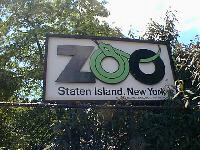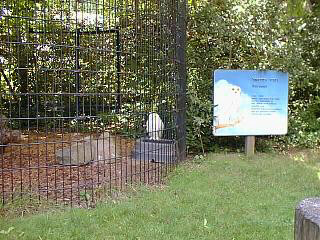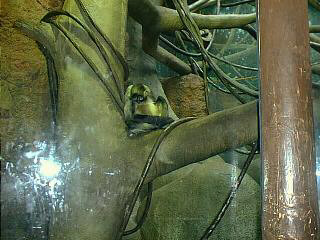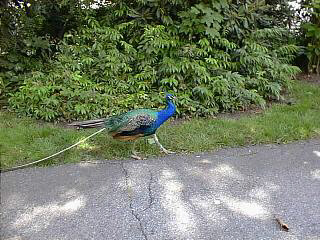
ARE ZOOS A NECESSARY EVIL?
Sean Byrne
Professor Keefer
2 August 2000

As a child I can remember when I misbehaved the absolute worst punishment
my parents could inflict: I would be banished to my bedroom, the length of time
depending on the seriousness of the "crime." It seemed that every possible want
and desire I had while being punished was related to an activity just outside
the confines of that bedroom. The hours seemed like days and the time spent
"locked" in my room was unbearable. When I look back on those "torturous" days
of my childhood, I can't believe what the big deal was. If I hadn't been punished,
most likely I probably would have spent my free time in my bedroom anyway. Who
was I kidding, locked in a room with a TV set, all of my toys and comic books,
who could possibly consider being confined to this "habitat" as punishment?
While I wasn't "confined" for more than a day or two or put on display for other
kids in the neighborhood to observe, I can see a resemblance to the animals
that are locked up in their "rooms" at the zoo. While their rooms have most
of the same things as their natural habitats, it is the thought that they do
not get to leave after Mom or Dad has finally broken down and absolved them
of their crime. This is their life for the foreseeable future. They haven't
misbehaved and they certainly did nothing worthy of being punished for. What
right do we have to exert our authority over other non-human species? Shouldn't
animals be afforded the same basic rights as you and I? It is my belief that
despite their professed concern for animals, zoos remain more "collections"
of interesting "items" than actual havens or simulated habitats. Zoos teach
people that it is acceptable to keep animals in captivity, bored, cramped, lonely
and far from their natural homes.
More than 2,300 years ago, the philosopher Aristotle wrote that men were by
nature superior to woman and that slaves lived for the sake of their masters.
A century later, the Greek Stoic Chrysippus claimed that horses and oxen existed
so they could labor for us and that "as for the pig, that most appetizing of
delicacies, it was created for no other purpose than slaughter, and God, in
furnishing our cuisine, mixed soul in with its flesh like salt" (Wise 10). It
is the belief that non-human animals are somehow made for our benefit that causes
us to treat animals the way we do. Our DNA and that of chimpanzees are more
than 98.3 percent identical. Scientists now believe that humans and chimpanzees
may differ by only several hundred genes out of approximately 100,000. A mere
fifty genes may control differences in our cognition. If Aristotle and Chrysippus
were aware of how similar we are to chimps, would they still have held their
beliefs? If most people today were cognizant of this fact, would they still
feel comfortable putting animals in zoos?
Zoo conditions can range from being a fairly accurate although drastically smaller
version of an animal's habitat to small, cold, sterile "cages" where little
thought or feeling for the animals' mental or physical condition is given. Animals
who naturally live in large herds or family groups are often kept alone, and
their natural hunting and mating behaviors are virtually eliminated by regulated
feeding and breeding regimens. Because of their close confinement, animals get
little or no mental or physical exercise. Virginia McKenna, star of the movie
Born Free and now an active campaigner on behalf of captive animals: "It is
the sadness of zoos which haunts me. The purposeless existence of the animals.
For the four hours we spend in a zoo, the animals spend four years, or fourteen,
perhaps even longer - if not in the same zoo then in others - day and night:
summer and winter� This is not conservation and surely it is not education.
No, it is entertainment. Not comedy, however, but tragedy".
If it were not enough to take animals and keep them in captivity, many zoos
over the years have been cited for numerous violations of animal cruelty to
the animals entrusted in their care. In December 1999, a video exposé
showed Sissy, an elephant at the El Paso Zoo, restrained by all four legs, being
repeatedly beaten by zoo workers with large wooden bats. Soon after the video
was released, the El Paso City Council voted unanimously to allow Sissy to retire
to an Elephant Sanctuary in Tennessee. The zoo director was forced to resign,
and the USDA charged the zoo with violations of the federal Animal Welfare Act
(which the zoo decided to settle out of court). Several years ago as reported
in the Los Angeles Times, the San Diego Zoo was the scene of a similar horrific
act. An African Elephant being transferred to the Zoos Wild Animal Park was
chained, pulled to the ground, and beaten with ax handles for two days. "You
have to motivate them," say San Francisco zookeeper Paul Hunter of elephants,
"and the way you do that is by beating the hell out of them" ( Fritsch).
The life of boredom that goes along with captivity often causes animals to
engage in abnormal and self-destructive behavior known as "zoochosis". You're
most likely to find this word used by animal rights activists in reference to
what they see as the degrading effect of zoos on the animals they contain. The
Internet website World Wide Words describes
the term : "Many animals, especially the large carnivores, become deeply depressed,
even psychotic, as the result of captivity. Symptoms of zoochosis include nervous
pacing, head rocking, and self-mutilation. The problem is perhaps most acute
with polar bears, which have proved especially difficult to keep sane, and which
often show disturbed behavior such as swimming for hours in small circles. The
Central Park Zoo in New York had to call in an animal psychologist to find ways
to give its polar bear, Gus, a more varied and challenging environment".
It was with this knowledge that I decided to make a trip to the zoo I had most
frequented as a child, the Staten Island Zoo. I always remembered having a great
time at that zoo and thought it might make for some interesting observations
now that I am an adult. I started to remember some of the things that made the
experience so fun for me. There was a petting zoo where children could feed
and interact with various animals like goats, deer and horses. They had a cool
Reptile House with a wide variety of lizards and snakes and a African Savannah
exhibit showcasing many of the wild animals from Africa such as monkeys, lions
and tigers. With all those animals behind its doors, you might think this zoo
sounds pretty big zoo, right? Well as I recently discovered, the Staten Island
Zoo, which opened its doors in 1936, is situated on only eight sprawling acres
of parkland. Yes, only eight acres of land. For a size comparison, Washington
Square Park in New York City, which is not a very large park, is approximately
ten acres. That's not a lot of land for a zoo that hosts over 637 different
animals.

The Staten Island Zoo had not seemed to change one bit from my last visit over twenty years ago. The sights, sounds and smells I encountered upon entering the gates brought back many vivid memories for me. I picked up a copy of the zoos' brochure and proceeded to map out my trip. My first stop was a cage situated on the lawn about 8 to 10 feet high just inside the entranceway of the zoo. Inside the cage were two beautiful Snowy Owls who somehow seemed oblivious to the noise of the cars driving bye the zoo not 15 feet away. The sign outside the cage gave very little useful information and the only thing I learned was that these owls were very far away from their natural home in the Arctic. It wasn't until I had done my own research that I discovered some interesting things, including the fact that these owls are the official birds of Quebec. If the zoo is going to cage these birds thousands of miles away from their natural habitat under the guise that they are educating the public, then they're going to have to do a much better job.
I then made my way to the Serpentarium, which is a fancy name for the Reptile
House. Upon entering the "house" the first animals on display were small turtles,
lizards and snakes in tanks the size of a shoebox which were in turn placed
inside of an artificial rock wall to give the appearance of being "natural"
exhibit. Beside the nameplates next to each animals cubicle there was no information
at all to help me better understand these creatures. Were they close to extinction,
were they endangered, or did their natural habitats consist of a solitary life
in a small glass box with mysterious faces peering in on them all day? Most
likely not, but you would never know by this zoos' emphasis on "education".
The alligators were always one of my favorites, so I was looking forward to
see what changes if any had occurred to the exhibit over the years. I'm not
sure if it was just my bad memory, but the cage actually looked a lot smaller
than I remembered it. There were four large alligators confined to a space no
bigger than a small office. The zoo curators seem to have gone that extra mile
for detail by painting the walls "swimming pool" blue, just like in the Everglades.
I looked for one of those doors that you usually see in the cages that allow
the animals to move into another holding area, but no such luck, this was it.
I'm sure the kids went home content with the knowledge that the alligator' natural
habitat looks like the kiddy pool at the YMCA as opposed to the beautiful Everglades.
Under the guise of research and against my better judgment I begrudgingly
carried on with the tour. Next stop, the African Safari. I was always fond of
visiting the monkeys and even as a child I felt a sadness about their existence
in captivity because of their close resemblance to humans. I can't say I was
surprised by what I saw when I entered the exhibit. There were two Spider Monkeys,
which happen to be endangered species sitting in a "simulated habitat" which
consisted of a few tree branches, and a rope. The monkeys just lay there looking
bored beyond belief as children yelled, pointed and knocked on the glass. While
the cause to save endangered animals is a noble and necessary one, is the trade
off that animals are sentenced to live in an alien environment that bears no
resemblance to their natural habitat, with no hope of being returned to the
wild acceptable? The sight of endlessly pacing and bored animals makes me wonder
just how fortunate they are to be protected.
The pictures of the animals from the zoo brochure all seemed to look like
the "headshot" photos that models use or the class photo that you used to get
when you were in school. There was absolutely no trace of the tiny cages that
they inhabit or the bored and unmotivated existence that they are living. Judging
by the brochure it seemed that everything was just fine at the Staten Island
Zoo. Why wouldn't it be, the zoo is a New York City owned facility and is supported
in part by annual appropriations from the Department of Cultural Affairs. The
Staten Island Zoo is also one of 184 accredited members of the American Zoo
and Aquarium Association. The AZA, which was established in 1924, represents
virtually every professionally operated zoological park aquarium, oceanarium
and wildlife park in North America. What exactly does it mean to be accredited
by the AZA? According the AZA website: "The accreditation process was designed
to evaluate zoos and aquariums in order to bolster public confidence by certifying
that an institution meets certain standards. Every zoo and aquarium must be
accredited in order to become a member of AZA. The accreditation process also
includes a peer review every five years to verify the maintenance of high standards
required for continuation of membership." Unfortunately, the AZA only provides
direction on ethical issues involving animal health and welfare. What that basically
means is that by keeping their animals in such small quarters, the Staten Island
Zoo is breaking no laws, and is in full compliance with the AZA and its guidelines.
I'm sure the Staten Island Zoo and its employees genuinely care for the animals
they are entrusted with, most people who work at zoos do. But in my opinion
to knowingly subject these animals to such unsuitable habitats is unacceptable.
I begin to realize that obtaining an interview with a zoo curator or employee
was going to be difficult. My e-mail requests were all declined and during my
visit to the Staten Island Zoo I was told the personal were too busy. While
I'm pretty sure that all the zoos I had contacted really were busy, I couldn't
help but think that as soon as I mentioned the words "research paper" a red
flag went off in their heads that said "Do not talk to this person, nobody writes
a positive research paper on zoos!". But I'm sure that's just my active imagination.
I still wanted to talk to someone who felt differently about zoos. Someone who
did not see the small cages but instead saw only the beautiful animals inside.
Someone who loved those animals and simply enjoyed that they were there, for
all the world to see. I decided to interview some children that I know who love
zoos and would not be shy about telling me why.
I spoke to two young girls, ages 8 and 9 who love animals and like to frequent
zoos. When asked what it was about the zoo that was so appealing, their answer
was quite simply that they love to see animals, especially animals from different
parts of the world. By visiting the zoo, they learned about animals feeding
habits and where it was that these animals' natural habitats were. As to why
the animals were in the zoo, one child stated that were it not for the zoo the
animals would most likely be killed and the other child felt that animals should
be collected for everyone to see. The San Diego Zoo and the Bronx Zoo were favorites
because of their large natural looking animal habitats. They also realized that
the animals' zoo homes did not really resemble their natural habitats and that
in the smaller exhibits where the animals were in close proximity behind bars,
the animal was most likely unhappy and sad.
As a child and even now as an adult, I share a lot of the girls' views on
animals and zoos. I have found in my research that there are good zoos that
do serve a useful purpose to both animal and man. The San Diego Zoo and the
Bronx Zoo are two examples of zoos that offer spacious, realistic and species
sensitive habitats while also educating and informing the public of its endangered
species. The San Diego Zoos work to protect, preserve and hopefully one day
restore endangered animals to their natural habitats is commendable. But it
is the animals that are not in danger of being extinct that are kept in zoos
that concerns me. Yes, the chance to view animals that you might never be afforded
the opportunity to view is exciting for many people. But look at it this way,
most people will never get the chance to visit the Great Wall of China, simply
because it's too far and too expensive to travel there and view it. Does not
mean it should be disassembled and put on display all over the world so people
can enjoy it? There are numerous people, places and cultures that most people
will never meet or experience. Should we put them all in a traveling road show
so we can observe them at our convenience? Certainly not, so why is it all right
to take animals from their natural habitats and put them on display for our
enjoyment?

With the use of the Internet, it is now possible to experience animals undisturbed
in their simulated habitats. Most zoos now feature Virtual Zoo Exhibits on their
websites that allow viewers to experience the sights and sounds of the animals
without the intrusion of humans. Unfortunately, most of the current Virtual
Zoos offered are more like commercials designed to entice you to visit the "real"
zoo. The concept however shows promise. A website based in Italy offers Internet
viewers pictures of hundreds of animals complete with sound and background information
that is more extensive than some zoos. In Henderson, Nevada students and teachers
at Brown Junior High created there own Virtual Zoo as well. Students from all
over the world are encouraged to enjoy and even participate in the maintenance
of the "zoo". Granted, while this is not the same as seeing animals live and
in person, it is the attempt to satisfy the public appetite for viewing animals
and respecting the animals rights that I find so encouraging. Hopefully, someday
animals will be able to be observed by people while peacefully existing in their
own natural habitats.

Ultimately, the only way to save endangered species and in turn eliminate
the only useful purpose of a zoo is to save their habitats and address the reasons
people kill them. Groups such as the Born Free Foundation, an international
wildlife charity believe that wildlife belongs in the wild and is dedicated
to the conservation of rare species in their natural habitat, and the phasing
out of traditional zoos. The Born Free Foundation was founded by the actors
Virginia McKenna and Bill Travers following their starring roles in the classic
wildlife film 'Born Free'. Born Free works to change animals' lives for good,
to investigate cruelty and neglect, and to raise awareness about wildlife issues.
Animal Rights groups such as PETA, while often extreme in their views and methods,
work tirelessly to expose zoo abuses which result in media exposure and worldwide
concern and action. But as a result of the research I've done, I believe that
the public and everyone who has a love for animals needs to become involved
too. As I was leaving the Staten Island Zoo I noticed a sign at the exit that
stated the zoo was currently being remodeled (for aesthetics, not size) and
they apologized because their larger animals such as the lions and tigers were
currently in other zoos until the work was done. I didn't know whether to laugh
or cry that this zoo that I thought too small was actually missing a good portion
of its animals. I decided that I now had an emotional attachment to the issue
of zoos and instead of just writing a research paper and forgetting about it,
maybe I should take my own advice to get involved and write a letter of complaint
to the AZA about the Staten Island Zoo.
Works Cited
Born Free Foundation 2000. Born Free Foundation < www.bornfree.org.uk
>
Brown JHS Virtual Zoo. March 1998. Clark County School District.
< www.ccsd.net/schools/brown/zoo/index.html >
Fritsch, Jane "Elephants in Captivity: A Dark Side," LA Times 5 Oct. 1998
McKenna, Virginia. Beyond the Bars, 1987
Peta Action Alerts. June 2000. People for the Ethical Treatment of Animals
www.peta-online.org
Smith, Val & Kimberly. Personal Interview. 27 July 2000.
World Wide Words. Ed. 2000. Michael B. Quinion. www.quinion.com
Wise, Steven, Rattling the Cage : Toward Legal Rights For Animals. New York:
Perseus, 2000. 
Zoo Animals To Go. June 2000. Mecury Center <www.mercurycenter.com>
Zoocheck. June 2000. Zoocheck Canada < www.zoocheck.com
>
Zoo in the Wild Editrice del Vascello. 2000 Editrice de Vascello
<http://www.naturalia.org/ZOO/welcome.html>